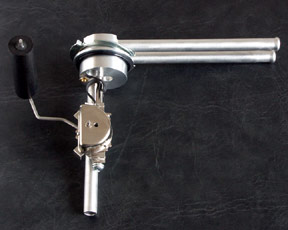
Volume 3, Issue 1
June 2009
Unsubscribe
Our 1100HP pumps will easily supply enough fuel for 1100 hp if the fuel tank is in front of the engine. But since most tanks/cells are at the rear of the car, frictional losses and gee forces must be taken into account.
Mechanical pumps rely on atmospheric pressure to force the fuel forward. The pump creates a vacuum and the atmosphere pushes the fuel forward (make sure you have a good vent in the tank!). At sea level, the atmospheric pressure is about 14 or 15 psi. However, no pump pulls a perfect vacuum, so maybe you achieve 12 psi of pressure differential to push the fuel. (And of course, the pump must also be able to provide sufficient volume for your engine, not just vacuum).
There is about 9 or 10 feet between the fuel tank and the mechanical pump. About 3 psi of pressure is required to overcome every one gee of acceleration. If a car launches really hard, it might create 2 gees, at least in first gear. That means we need 6 psi just to fight 2 gees. Subtracting 6 from our 12 psi leaves us with 6 psi at the carb.
And lets not forget line friction. If you run 3/8" line from the tank to the carb, you will loose about 3 psi more with a 140 gph pump. Now you have only 3 psi at the carb during first gear with a 2 gee launch. However, if you run 1/2" line, the pressure drop due to friction is only about 1/2 psi so our pressure at the carb is back up to 5.5 psi. Lesson? RUN A LARGE FUEL LINE FROM THE TANK TO THE PUMP.
Fortunately, most cars, even 9 second cars, don't pull over 1 gee for more than the first second. So a large mechanical pump using large lines can easily supply enough fuel for a 9 second car, especially if the pump is a high pressure pump that requires a regulator.
Low pressure pumps do not require a regulator and may seem like a way to save a little money. However, low pressure pumps (electric or mechanical) will always result in more pressure drop during wide open throttle acceleration than a high pressure pump using a regulator.
The pressure produced by any fuel pump decreases as the flow increases. This is simply a law of physics. Maximum pressure occurs when the flow is zero (such as at idle), zero pressure occurs at maximum flow (free flow). When you use a pump that requires no regulator, the maximum pressure is usually about 7 psi. When you stand on the go pedal, the volume goes up and the pressure drops, maybe as much as 4 or 5 psi depending on the size of the pump.
When you use a high pressure pump (say one that produces a maximum pressure of 14 psi) and a regulator, the pressure produced by the pump still drops during full throttle, however, even if it drops 5 psi (to 9 psi), the pressure delivered to the regulator is still higher than the set pressure of the regulator (say 7 psi) so the pressure delivered to the carb doesn't change, or changes very little.
— Robb

RobbMc 1/2" Sending Units
Drop-in replacement for factory 5/16" or 3/8" sending units. Budget alternative to a fuel cell or weld-on sump. Recommended for cars with engines over 450 hp. Recommended for all cars with an electric fuel pump and return/bypass style regulator
Applications
1964-67 GM A-Body
1968-72 GM A-Body
1967-69 GM F-Body
1970-73 GM F-Body
1974-81 GM F-Body
1968-72 GM X-Body
1973-79 GM X-Body
Coming soon! Fuel Sending Units for Ford Mustang
Features
Sending Unit Options:
–8AN Male Fittings
Added to the ends of the feed and return tubes.
Reducer, 1/2" to 1/4" hose
Required when using a mechanical pump with 1/4" vapor return line.
RobbMc 1/2" Sending Units are now available. Order by phone or online through our secure Paypal shopping cart.
RobbMc Performance Products
775.885.7411
Drop-in replacement for factory 5/16" or 3/8" sending units. Budget alternative to a fuel cell or weld-on sump. Recommended for cars with engines over 450 hp. Recommended for all cars with an electric fuel pump and return/bypass style regulator
Applications
1964-67 GM A-Body
1968-72 GM A-Body
1967-69 GM F-Body
1970-73 GM F-Body
1974-81 GM F-Body
1968-72 GM X-Body
1973-79 GM X-Body
Coming soon! Fuel Sending Units for Ford Mustang
Features
- 1/2" pickup and feed tubes reduce flow restriction to suction side of fuel pump
- 1/2" return tube allows use of a return/bypass regulator without modifying the fuel tank or switching to a fuel cell
- Return tube can be capped off if no return line is used
- Use with a reducer to connect 1/4" vapor return line from a mechanical pump
- Billet aluminum base and aluminum tubes are anodized for use with gasoline or alcohol
- Stainless fuel level sending unit works with OEM fuel level gauges (0-90 ohm)
- Eliminates restrictive, difficult to service intank "sock" filter. Use with RobbMc inline prefilter
- MADE IN THE USA
Sending Unit Options:
–8AN Male Fittings
Added to the ends of the feed and return tubes.
Reducer, 1/2" to 1/4" hose
Required when using a mechanical pump with 1/4" vapor return line.
RobbMc 1/2" Sending Units are now available. Order by phone or online through our secure Paypal shopping cart.
RobbMc Performance Products
775.885.7411
To unsubscribe from the free RobbMc Performance Newsletter, click the "Unsubscribe" link at the top of this newsletter. Or send an email to news@robbmcperformance.com and place the word "Remove" in the subject line of the email.